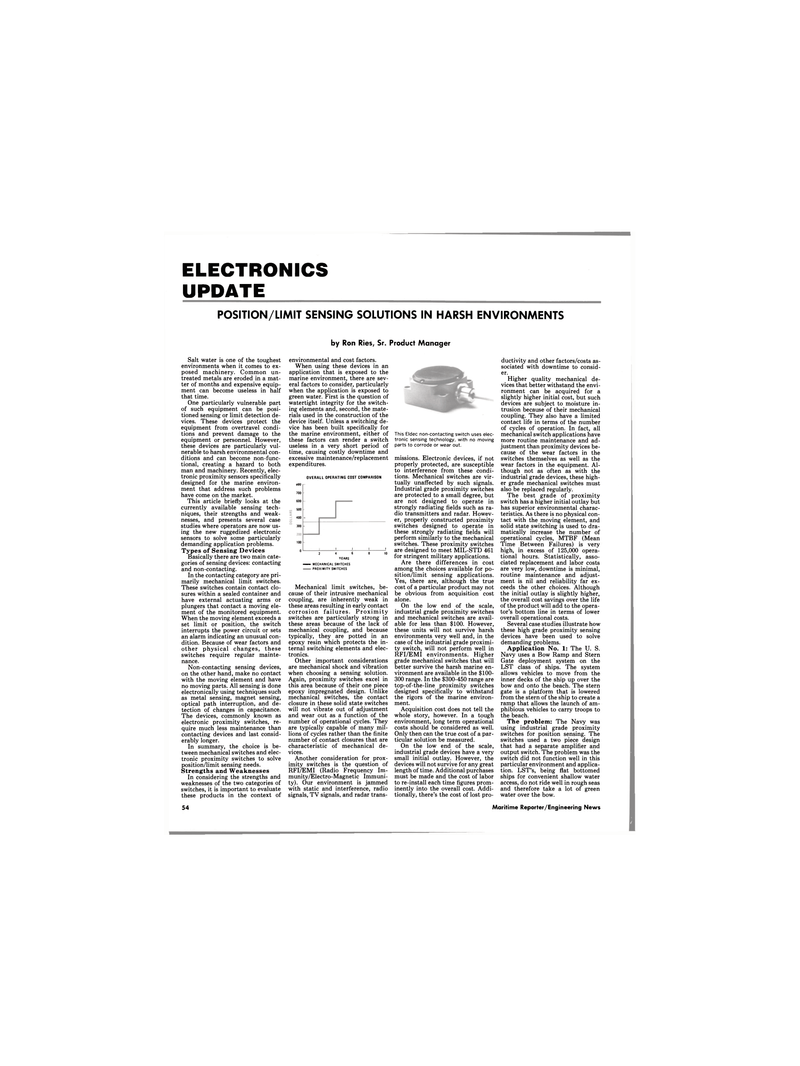
Page 54: of Maritime Reporter Magazine (April 1988)
Read this page in Pdf, Flash or Html5 edition of April 1988 Maritime Reporter Magazine
ELECTRONICS
UPDATE
POSITION/LIMIT SENSING SOLUTIONS IN HARSH ENVIRONMENTS by Ron Ries, Sr. Product Manager
Salt water is one of the toughest environments when it comes to ex- posed machinery. Common un- treated metals are eroded in a mat- ter of months and expensive equip- ment can become useless in half that time.
One particularly vulnerable part of such equipment can be posi- tioned sensing or limit detection de- vices. These devices protect the equipment from overtravel condi- tions and prevent damage to the equipment or personnel. However, these devices are particularly vul- nerable to harsh environmental con- ditions and can become non-func- tional, creating a hazard to both man and machinery. Recently, elec- tronic proximity sensors specifically designed for the marine environ- ment that address such problems have come on the market.
This article briefly looks at the currently available sensing tech- niques, their strengths and weak- nesses, and presents several case studies where operators are now us- ing the new ruggedized electronic sensors to solve some particularly demanding application problems.
Types of Sensing Devices
Basically there are two main cate- gories of sensing devices: contacting and non-contacting.
In the contacting category are pri- marily mechanical limit switches.
These switches contain contact clo- sures within a sealed container and have external actuating arms or plungers that contact a moving ele- ment of the monitored equipment.
When the moving element exceeds a set limit or position, the switch interrupts the power circuit or sets an alarm indicating an unusual con- dition. Because of wear factors and other physical changes, these switches require regular mainte- nance.
Non-contacting sensing devices, on the other hand, make no contact with the moving element and have no moving parts. All sensing is done electronically using techniques such as metal sensing, magnet sensing, optical path interruption, and de- tection of changes in capacitance.
The devices, commonly known as electronic proximity switches, re- quire much less maintenance than contacting devices and last consid- erably longer.
In summary, the choice is be- tween mechanical switches and elec- tronic proximity switches to solve position/limit sensing needs.
Strengths and Weaknesses
In considering the strengths and weaknesses of the two categories of switches, it is important to evaluate these products in the context of environmental and cost factors.
When using these devices in an application that is exposed to the marine environment, there are sev- eral factors to consider, particularly when the application is exposed to green water. First is the question of watertight integrity for the switch- ing elements and, second, the mate- rials used in the construction of the device itself. Unless a switching de- vice has been built specifically for the marine environment, either of these factors can render a switch useless in a very short period of time, causing costly downtime and excessive maintenance/replacement expenditures.
OVERALL OPERATING COST COMPARISON flUU 700 600 500 400 - 300 - 100 n i i i i 2 4 6 8 10
YEARS — MECHANICAL SWITCHES
PROXIMITY SWITCHES
Mechanical limit switches, be- cause of their intrusive mechanical coupling, are inherently weak in these areas resulting in early contact corrosion failures. Proximity switches are particularly strong in these areas because of the lack of mechanical coupling, and because typically, they are potted in an epoxy resin which protects the in- ternal switching elements and elec- tronics.
Other important considerations are mechanical shock and vibration when choosing a sensing solution.
Again, proximity switches excel in this area because of their one piece epoxy impregnated design. Unlike mechanical switches, the contact closure in these solid state switches will not vibrate out of adjustment and wear out as a function of the number of operational cycles. They are typically capable of many mil- lions of cycles rather than the finite number of contact closures that are characteristic of mechanical de- vices.
Another consideration for prox- imity switches is the question of
RFI/EMI (Radio Frequency Im- munity/Electro-Magnetic Immuni- ty). Our environment is jammed with static and interference, radio signals, TV signals, and radar trans-
This Eldec non-contacting switch uses elec- tronic sensing technology, with no moving parts to corrode or wear out. missions. Electronic devices, if not properly protected, are susceptible to interference from these condi- tions. Mechanical switches are vir- tually unaffected by such signals.
Industrial grade proximity switches are protected to a small degree, but are not designed to operate in strongly radiating fields such as ra- dio transmitters and radar. Howev- er, properly constructed proximity switches designed to operate in these strongly radiating fields will perform similarly to the mechanical switches. These proximity switches are designed to meet MIL-STD 461 for stringent military applications.
Are there differences in cost among the choices available for po- sition/limit sensing applications.
Yes, there are, although the true cost of a particular product may not be obvious from acquisition cost alone.
On the low end of the scale, industrial grade proximity switches and mechanical switches are avail- able for less than $100. However, these units will not survive harsh environments very well and, in the case of the industrial grade proximi- ty switch, will not perform well in
RFI/EMI environments. Higher grade mechanical switches that will better survive the harsh marine en- vironment are available in the $100- 300 range. In the $300-450 range are top-of-the-line proximity switches designed specifically to withstand the rigors of the marine environ- ment.
Acquisition cost does not tell the whole story, however. In a tough environment, long term operational costs should be considered as well.
Only then can the true cost of a par- ticular solution be measured.
On the low end of the scale, industrial grade devices have a very small initial outlay. However, the devices will not survive for any great length of time. Additional purchases must be made and the cost of labor to re-install each time figures prom- inently into the overall cost. Addi- tionally, there's the cost of lost pro- ductivity and other factors/costs as- sociated with downtime to consid- er.
Higher quality mechanical de- vices that better withstand the envi- ronment can be acquired for a slightly higher initial cost, but such devices are subject to moisture in- trusion because of their mechanical coupling. They also have a limited contact life in terms of the number of cycles of operation. In fact, all mechanical switch applications have more routine maintenance and ad- justment than proximity devices be- cause of the wear factors in the switches themselves as well as the wear factors in the equipment. Al- though not as often as with the industrial grade devices, these high- er grade mechanical switches must also be replaced regularly.
The best grade of proximity switch has a higher initial outlay but has superior environmental charac- teristics. As there is no physical con- tact with the moving element, and solid state switching is used to dra- matically increase the number of operational cycles, MTBF (Mean
Time Between Failures) is very high, in excess of 125,000 opera- tional hours. Statistically, asso- ciated replacement and labor costs are very low, downtime is minimal, routine maintenance and adjust- ment is nil and reliability far ex- ceeds the other choices. Although the initial outlay is slightly higher, the overall cost savings over the life of the product will add to the opera- tor's bottom line in terms of lower overall operational costs.
Several case studies illustrate how these high grade proximity sensing devices have been used to solve demanding problems.
Application No. 1: The U. S.
Navy uses a Bow Ramp and Stern
Gate deployment system on the
LST class of ships. The system allows vehicles to move from the inner decks of the ship up over the bow and onto the beach. The stern gate is a platform that is lowered from the stern of the ship to create a ramp that allows the launch of am- phibious vehicles to carry troops to the beach.
The problem: The Navy was using industrial grade proximity switches for position sensing. The switches used a two piece design that had a separate amplifier and output switch. The problem was the switch did not function well in this particular environment and applica- tion. LST's, being flat bottomed ships for convenient shallow water access, do not ride well in rough seas and therefore take a lot of green water over the bow. 54 Maritime Reporter/Engineering News

 53
53

 55
55
